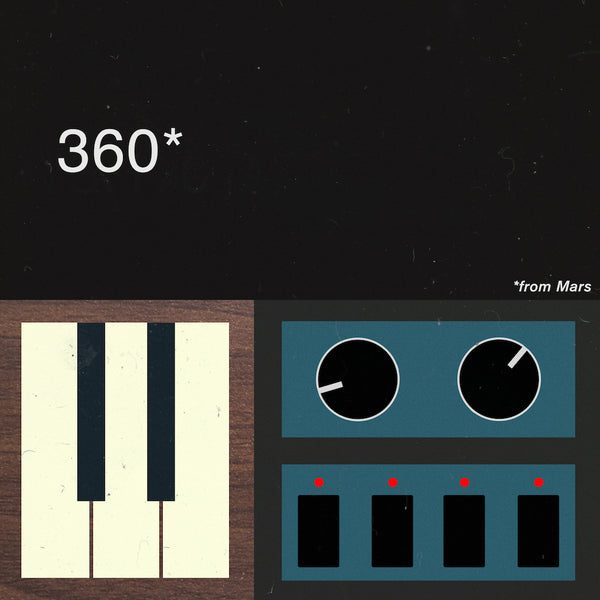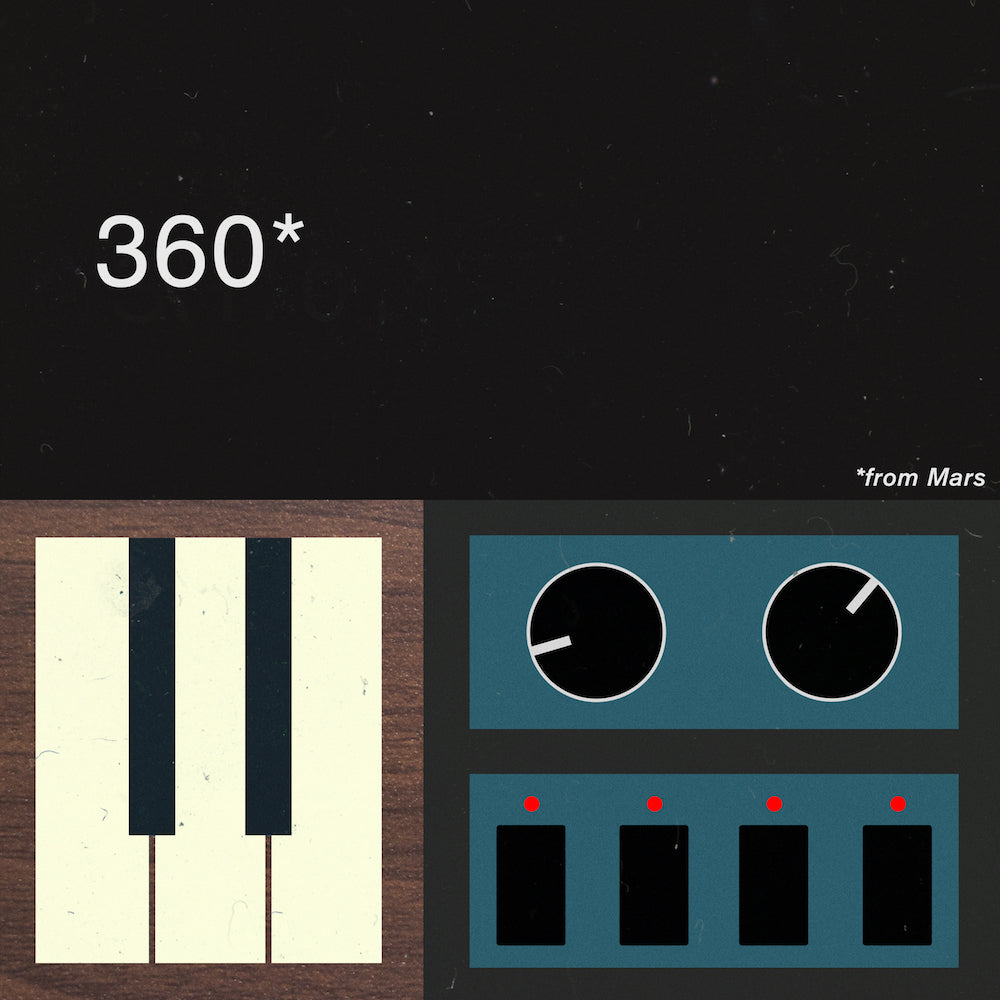360 FROM MARS
$39.00 $19.50
One of the Earliest Multi-Sampled Synthesizers
The 360 Systems Keyboard is a rare, sampled-based synth made in California in the early '80s, featuring real strings, flutes, brass, electric piano, basses, guitars, percussion, and more. Sharing similar components (EPROMs and an analog filter) as some of our favorite vintage drum machines, it's no wonder the 360 is as punchy as our favorite samplers, and as silky as our vintage synths.

So why then, have we never heard of it? Because, despite its grandiose vision to be a smaller and more portable alternative to the Mellotron, the 360 ultimately missed the mark for commercial success. Only 200 were made, and as a result, its epic sounds have gone largely unused...until now!
Humble Beginnings
The 360 was created by an electronic musician who had always admired the sound of traditional instruments, but wanted a cheaper alternative - something that could be taken on tour. While samplers like the Emulator had started to hit the market just a few years earlier, the sampling pioneers of the day were no longer impressed with the unrealistic sound of single samples stretched across the whole range of a keyboard.
The 360 was originally intended as a solution to this problem. It was one of the first experiments in multi-sampling, with each patch boasting between 4-24 separate samples, some as long as 8 seconds! This advanced sampling technique used an extraordinary amount of memory for the time (2 megabytes 🥳), which required nearly 50 EPROMS!

Unfortunately, the grand vision of the 360 ultimately proved too expensive for consumers (£3,500 – $13,401 USD today 😯) and too limited for professionals and studios (due to budget, it was not velocity sensitive, and did not loop any sounds). Further information about the 360 is scarce, and the machines themselves are even scarcer.

The Sound
The sound of the 360 is a combination of beautifully captured samples (recorded at the best studios in Los Angeles with top tier session musicians) and the inherent lo-fidelity crunch of EPROMs passing through a sweet CEM3320 analog filter (which we’ve come to love from the Lindrum and Prophet V, to name a few).
So does it emulate real instruments well by today’s standards? Probably not. But the instruments punch way harder than your typical modern multi-samples:
But while the multi-samples were supposed to make the instruments more real sounding, they actually make a lot of patches sound even MORE unnatural - however it's these apparent shortcomings that make the 360 so charming, unmistakeable, and unique. The 360 forces even the best keyboardists to play differently, and things get quite interesting when you put its sounds in a modern context:
Sampling the 360 Cleanly
The 360 originally shipped from the factory in a number of different configurations - you could get a heavily multi-sampled grand piano version (that resultantly has less other patches) or a setup like ours, that came with 20 factory patches (but no grand piano).

We sampled every note of every patch (to preserve the great sound of the 360’s tuning), cleanly through a Radial JDI, into our API 1608 and finally into our Apogee Symphony MKII.
Adding Modulation
Next, we set out to spice things up a bit. The 360 only offers basic modulation, but it sounds excellent. The vibrato section modulates the pitch in a classic style that imparts the vintage warble that we all love:
Perhaps equally important to the sound is the filter. While making music with the 360, it was obvious how much the filter helped certain sounds cut through the mix. So we captured filtered versions of the strings, flute, sax, and more.

Where fitting, we also multi-sampled different cutoffs, which can be accessed via incoming velocity from your midi keyboard:
Adding External FX
Once we’d covered our bases capturing all of the presets cleanly, we experimented with processing some of our favorite patches - the goal being to create an inspiring, alternate version by introducing external processing and modulation.
Keeping almost everything in the chain vintage, we reached for our Otari tape machine to re-pitch and pan the strings, adding Space Echo and H3000 chorusing. We even ran the electric piano patch through our trusty CS5 synthesizer, which allowed us to filter and add a nice tremolo effect.

We purposefully kept the processing minimal, so as not to obscure the sound of the 360 - but it really does help to add a space and vibe that plugins still can't achieve:
What You Get
Ultimately we captured 37 total patches, including the 20 original sounds, and 17 multi-sampled and externally processed patches. We've kept the slow attack and natural decay on many of the samples, but also spent over 60 hours achieving perfect loops for 17 patches, making the 360 From Mars much more playable than the original machine.
Unlike sampling an analog synth, these instruments will get you much closer to, and perhaps an even better experience than, owning a real 360, due to its many limitations. And because they're samples, the sounds transferred very well to modern software.
Speaking of which, all of these patches are available to you as WAV files, and multi-sampled instrument presets for software such as Ableton, Logic, Kontakt, Reason, FL Studio, SFZ Player, and really any 24bit WAV compatible sampler or DAW.

In the End
Sampling back in the day was not the wide-spanning, creative endeavor it is today. It was more of an innovative experiment - a means of providing a solution to a problem. But even though the 360 never came close to replacing real instruments, looking back decades later, that's its charm.
So, if you set out to use the 360 programming midi riffs or classical string progressions - it may fall flat. But if you brave these sounds into your next modern composition, it may force you to think, play and write in a completely different and unique way. And who knows - you may even be the first one to make these sounds iconic!
Contents:
- 37 total 360 patches, organized into 7 categories
- 20 original Factory clean patches
- 12 clean patches with additional 360 filtering, vibrato, and chorus
- 5 patches externally processed through Moog MF103 Phaser, Yamaha CS-5, Otari 1/4" Tape machine, H3000 and Space Echo
- Classic vintage and orchestral sounds: Strings, Flute, E Piano, Clav, Trumpet, Saxophone, Timpani and more
- Brass & Woodwinds, Keys, Strings, Guitars, Bass, Stacked patches and Percussive instruments
- 2,065 24 bit WAV samples
- WAVs are trimmed, looped, named by note, and mapped to various samplers
- WAVs feature mapping and looping metadata, for easy drag n drop into unsupported samplers
- Recorded cleanly through an API 1608 console to Apogee Symphony Conversion
- Modwheel parameters and FX routing on all software instruments
- 1.96 GB Unzipped
- About
Ready For:
- Any 24 bit WAV Compatible DAW or Sampler
- Ableton Live 9.7+ (Not Intro)
- Kontakt 5.6.5+ (Not Kontakt Player)
- Logic 9+
- Reason 8+
- FL Studio 20.8+
- SFZ Player (Free, cross-platform solution for any DAW)
- 1.96 GB Free Space
Contents:
- 37 total 360 patches, organized into 7 categories
- 20 original Factory clean patches
- 12 clean patches with additional 360 filtering, vibrato, and chorus
- 5 patches externally processed through Moog MF103 Phaser, Yamaha CS-5, Otari 1/4" Tape machine, H3000 and Space Echo
- Classic vintage and orchestral sounds: Strings, Flute, E Piano, Clav, Trumpet, Saxophone, Timpani and more
- Brass & Woodwinds, Keys, Strings, Guitars, Bass, Stacked patches and Percussive instruments
- 2,065 24 bit WAV samples
- WAVs are trimmed, looped, named by note, and mapped to various samplers
- WAVs feature mapping and looping metadata, for easy drag n drop into unsupported samplers
- Recorded cleanly through an API 1608 console to Apogee Symphony Conversion
- Modwheel parameters and FX routing on all software instruments
- 1.96 GB Unzipped
- About
Ready For:
- Any 24 bit WAV Compatible DAW or Sampler
- Ableton Live 9.7+ (Not Intro)
- Kontakt 5.6.5+ (Not Kontakt Player)
- Logic 9+
- Reason 8+
- FL Studio 20.8+
- SFZ Player (Free, cross-platform solution for any DAW)
- 1.96 GB Free Space










